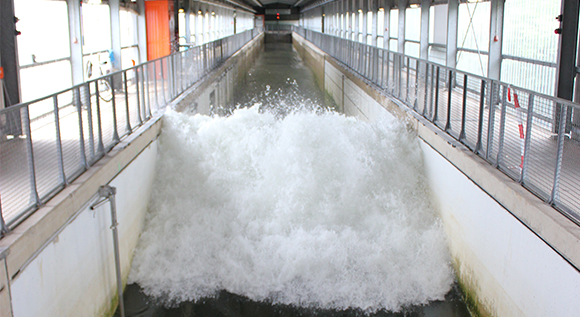Small monster waves with a big impact
A storm tide in the middle of Lower Saxony – the “Large Wave Flume” of the Forschungszentrum Küste in Hanover makes it possible. “marTech” is a major research project at which components for offshore wind energy converters are being tested..
 © Forschungszentrum Küste, Hannover
© Forschungszentrum Küste, Hannover
Offshore wind energy installations are making a major contribution to the success of Germany’s energy transition. However, they have to cope with extreme conditions out at sea. In 1995, for example, a 26 metre wave was recorded during a storm in the North Sea.
In future, researchers working on the new “marTech” research project will be able to simulate the impact of such monster waves on wind energy turbines on a scale of one to ten at the Large Wave Flume of Forschungszentrum Küste in Hanover. The 310-metre test flume, which is operated by Hanover’s Leibniz University together with Braunschweig’s University of Technology, will soon host a new wave generator making waves up to 2.7 metres high. Small-scale models of wind energy converters make it possible to study the impact of monster waves. This means we can build safe components and foundations.
Wind and waves: a test of endurance at sea and on the coast
In addition to the new wave generator, a unique current-generating system is being installed which can pump an extra amount of up to 12,500 litres of water per second through the flume. Also, the bottom of the flume will be lowered by 8 metres in order to resemble the actual seafloor. Both of these innovations will help scientists to study the interaction of waves and currents. The scientists want to conduct practical tests to find out how best to anchor the foundations of offshore wind turbines in the seabed, and how the sediment bed surrounding such foundations can best be protected by a “scour protection” formed of larger and smaller rocks. “In many cases, the dynamic marine currents and the movement of the waves wash away the seabed from around the foundations,” explains Professor Torsten Schlurmann of Hanover’s Leibniz University. “This phenomenon is rather like having wobbly teeth as a result of gum disease.” The marTech researchers intend to use the new, deep part of the wave flume to test different materials – e.g. Norwegian granite in different rock sizes – as a scour protection at different wave heights and in different currents.
The new features of the large wave flume are also intended to show how dykes in coastal regions can be made floodproof. Sea levels are rising as a result of climate change, and this is also affecting the demands placed on modern dyke construction. Also, tests are to show whether materials already being used in dyke construction can also be used to protect wind turbines. For example, geosynthetics are now being integrated into many dykes as they can withstand the waves and currents and protect the soil. The special sheets are easy to install, cheap and can be used for many different purposes – including protecting the foundations of offshore wind turbines.
Using waves to generate electricity
The marTech researchers are also studying forward-looking maritime energy technologies. They aim to use maritime energy installations to generate electricity reliably from wave motion and tidal movements. However, unlike traditional hydropower installations on rivers or in mountains, this technology is still at an early stage of development. The scientists are currently planning to test different components on floating pontoons in order to better evaluate not only the stresses on, but also the lifetimes of the components.
The Federal Ministry for Economic Affairs and Energy is providing funding of around €35 million for the marTech project.

